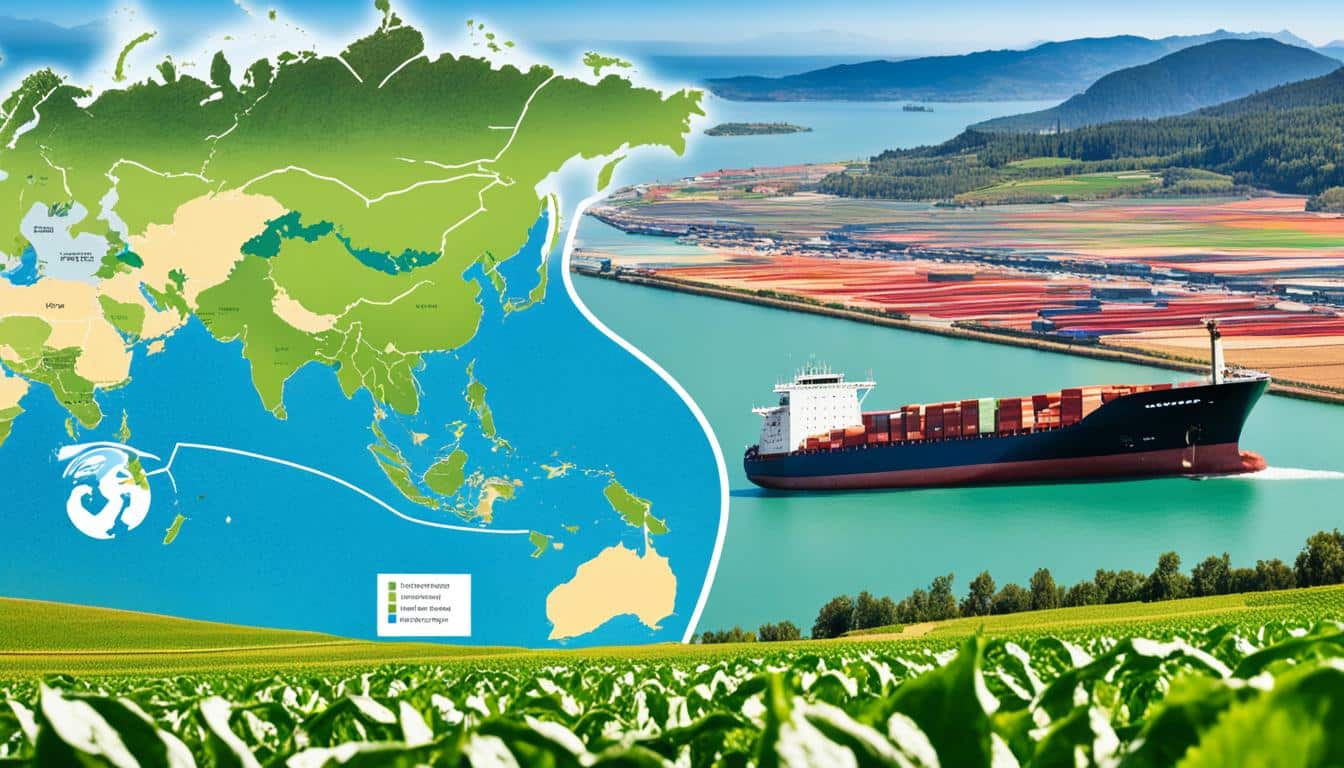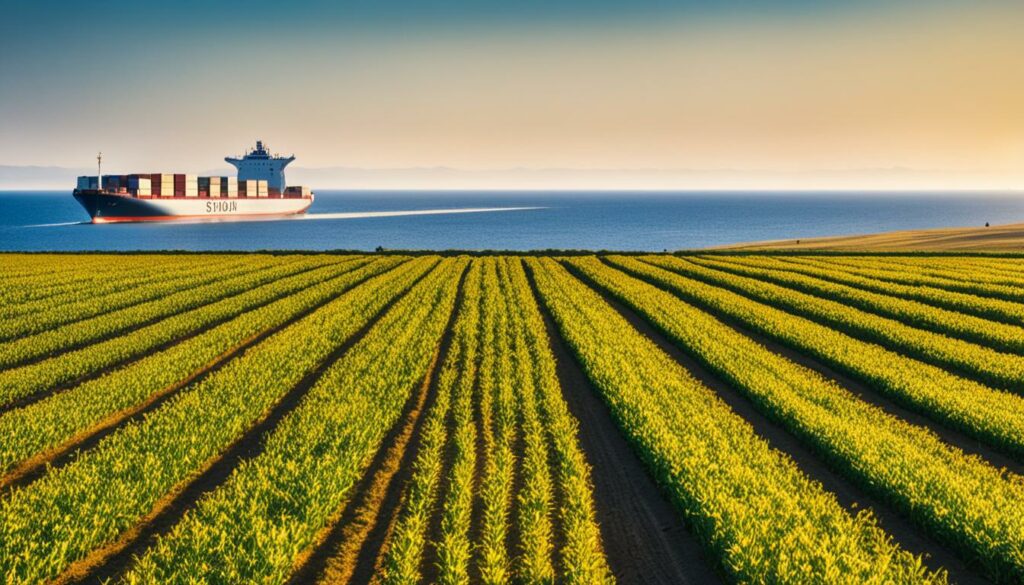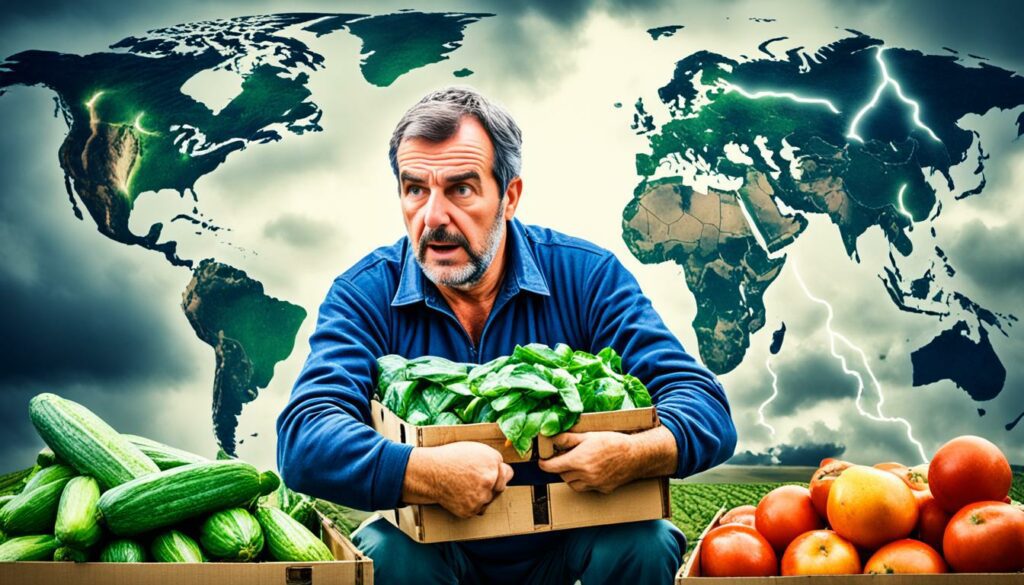Menu

Did you know that Dutch agricultural exports have risen in value? They are up by 3.6%. This growth is happening even though re-exports have gone down by 2%. It shows how the agricultural trade keeps changing at a global level. Current trends are also quite interesting. The Reserve Bank of Australia is seeing a slower rise in prices than they expected.
Unemployment in Australia stays in the high 3s and core inflation rates are moving a lot. Rents and services are driving these changes. At the same time, European countries like Sweden are cutting their interest rates.
This is happening before major players like the European Central Bank and the Bank of England take similar actions. Things are pointing towards the US Federal Reserve also cutting rates by September.
In Australia, exporters are dealing with a tricky situation. The Australian Dollar is getting stronger against other currencies. This is due to differences in interest rates and commodity prices. Despite these factors, there should be a slight surplus in the federal budget.
This surplus is thanks to strong commodities and a good job market. It is not expected to lead to much inflation. The budget will also include support for the cost of living and tax cuts.
This section is aimed at keeping you up to date with the latest in agricultural exports. We cover news, trends, and how the market is reacting. I want to ensure you have the most recent and clear picture of the agricultural export scene.
Agricultural exports are key for countries and global farming trade. In 2021, they made up 5.4 percent of the U.S. GDP. They also provided 10.5 percent of jobs in the U.S. These numbers show how vital exports are for the economy.
The trading landscape for agriculture is always changing, bringing new chances and hurdles. For example, the U.S. used to export more than it imported. But, by the end of FY 2022, the U.S. saw its agricultural trade go into a $3 billion deficit. This is mainly due to drops in certain sectors, like a huge fall in cotton exports because of severe drought.
Even with these challenges, the U.S. is the top global exporter of farm products. It sells about a fifth of its farm goods overseas. Still, the total value of these exports has been falling since 2014. This is partly because of lower prices for big farm goods and also the faster growth of imports over exports.
From December 2019 to February 2022, grain prices soared by 73.5 percent. The COVID-19 pandemic and events like the Russia-Ukraine conflict are major reasons for these price jumps. For example, when Russia invaded Ukraine, grain prices surged by 24.1 percent in just four months.
Over time, where the U.S. sends its exports has also changed. Since NAFTA, sending products to Canada and Mexico has greatly increased. Also, from 1997 to 2003, China bought only 4% of U.S. agriculture exports. But from 2011 to 2022, it rose to 15%. These changes are key in understanding the shifts in this trade.
The USDA is taking steps to boost U.S. agricultural exports. With the Regional Agricultural Promotion Program, it’s aiming to grow and vary export chances. Additionally, the USDA is planning trade missions to places like Seoul, New Delhi, and Bogota. This shows their strong effort to reach more international markets with U.S. products.
The agricultural export market is always changing, influenced by many factors. These include what consumers want and economic policies. The U.S. trade balance changed significantly in recent years. For the third year in five, it has imported more than exported. By November 2023, there was a $20 billion surplus in imports of farm products.

Looking closely, U.S. agricultural exports increased from $141 billion in 2019 to nearly $196 billion by 2022. However, 2023 trade data shows a shift. Reports indicate $143 billion in exports and $163 billion in imports. This shows changes in global and domestic demand, as well as economic conditions. For example, the U.S. exported millions in soybeans and corn. But, overall, it imported slightly less in 2023 than in 2022.
The U.S. Department of Agriculture (USDA) is looking to the future. They predict U.S. agricultural exports will be worth $169.5 billion next year. Meanwhile, imports are expected to hit $200 billion. This would lead to a $30.5 billion trade deficit.
| Year | Exports (Billion USD) | Imports (Billion USD) | Trade Balance |
|---|---|---|---|
| 2019 | 141 | 124 | Surplus |
| 2020 | 150 | 136 | Surplus |
| 2021 | 176.5 | 155.5 | Surplus |
| 2022 | 196 | 166 | Surplus |
| 2023 | 143 | 163 | Deficit |
| 2024 (Forecast) | 169.5 | 200 | Deficit |
Advancements in agriculture and changing consumer desires play a big role in these changes. In 2022, the top 10 export markets for the U.S. saw growth, with seven hitting records. Products like soybeans, corn, beef, dairy, cotton, and nuts made up more than half of the exports.
To stay competitive, it’s important to keep up with news and adapt. The rise in sales clearly shows that market understanding and smart positioning are key. This serves those aiming to succeed in a fiercely competitive market.
Big world events change how we trade farm products globally. Recently, pandemics and new trade deals have made a big impact. These events affect how we buy and sell agricultural goods all over the world.
COVID-19 changed global food trade a lot. Lockdowns and restrictions led to supply chain problems. This made things move slower and cost more to transport.
258 million people worldwide couldn’t find enough food in 2022. Food prices hit record highs in March that year. These challenges were hard for many countries to overcome.
Ukraine’s farming struggled badly because of the pandemic. Its GDP shrank over 29% in 2022. Farming’s part in Ukraine’s GDP fell by 39%. The country produced less wheat, corn, and barley. This situation shows how delicate our food supplies are.
New trade deals also changed how we export food. Ukraine, for example, was hit hard when Russia stopped the Black Sea Grain Initiative in 2022. This agreement helped Ukraine export products.
But Ukraine started sending more wheat to Europe instead. From just 2%, wheat exports to Europe jumped to half of its exports by February 2022. Corn sales to Europe rose above 64% after the war. This shows the value of being flexible in trade deals.
On the other hand, Russia reached a record in wheat production. But, war then caused prices of fertilizers to spike. The costs to grow food and export it rose because of these higher fertilizer prices.
| Region | Impact |
|---|---|
| Ukraine | Wheat down by 32%, corn down by 27%, barley down by 37%; sunflower area decreased by 15%. |
| Russia | Wheat production reached 51 mmt; spikes in fertiliser prices. |
| United States | $3 billion deficit in agricultural trade predicted to increase to $3.5 billion; drought affects cotton exports. |
| Global | World food prices at all-time highs; 258 million affected by food insecurity in 2022. |
Being up-to-date with agricultural export news is vital. The world continues to change. To keep growing and going, we need to know and respond to these changes. Staying flexible will help us meet the ongoing challenges.
Knowing the key global markets for agriculture exports is vital. The top players include the United Kingdom, the United States, and China. We will explore why these places matter so much for agriculture exports. We’ll back it up with facts and what the markets are like.

The UK is a strong buyer of agricultural goods, spending $30.04 billion in 2022. Despite its economy’s small agricultural share, it needs a lot of different products. Whether it’s grains or dairy, quality is a must for British buyers. This makes the UK very attractive for sellers everywhere.
The U.S. is a powerhouse in selling agricultural products abroad. In 2023, it sent $3.1 billion worth of goods to Vietnam, showing its reach. Products like processed foods, dairy, and fruits are in demand cause the U.S. does well in international markets. Their sales of tree nuts to Vietnam jumped 37%, reaching $238 million in 2023. This shows there are great opportunities for growth.
China is a leading exporter of agricultural goods. It was Vietnam’s main source for such products in 2023, selling $32 billion worth. China’s goods are very important for meeting various needs around the world. The high level of exports shows China’s key role in agriculture sales globally.
| Country | 2023 Agricultural Export Value (USD Billion) | Key Export Products |
|---|---|---|
| United Kingdom | 30.04 | Grains, Dairy, Meat, Fresh Produce |
| United States | 3.10 | Dairy, Fruits, Tree Nuts, Processed Products |
| China | 32.00 | Various Agricultural Commodities |
These top markets have a huge impact on agricultural exports. Sellers need to stay updated on market demands and rules in these areas. This helps them succeed in the tough global competition for agriculture sales.
The market for key agricultural products is always changing. Demand is up, influenced by economic policies and new trading trends. We’ll delve into cereals, fruits, and dairy, giving updates on products and spotting export chances.
In 2021, the cereals and grains area saw a big boost. The COVID-19 pandemic and events like Russia’s actions in Ukraine pushed up prices and changed how things were made.
The U.S. saw a huge increase in grain prices from 2019 to 2022. This was mainly because corn and wheat prices were affected by the pandemic. During the Ukraine conflict, there was a noticeable global rise in grain prices too. Even with a projected increase in production, climate change could cut corn in Iowa by 10% come 2030.
Export volumes for fruits and veggies have surged. This is thanks to a growing global desire for healthy, top-quality products. Since NAFTA was established, exports to key places like Canada and Mexico have nearly quadrupled. Horticultural items made up over half of the U.S.’s plant-based imports last year, showing strong trade in this field. Policies that help with transport problems and trading obstacles have played a key role in this sector’s success.
| Year | Total U.S. Exports | Vegetable Exports | Fruit Exports |
|---|---|---|---|
| 2020 | $150 billion | $17 billion | $15 billion |
| 2021 | $177 billion | $19 billion | $17 billion |
| 2022 | $196 billion (projected) | $20 billion (projected) | $18 billion (projected) |
The dairy sector is thriving too, with outstanding export numbers. Global demand for U.S. dairy drove this success. China was the top buyer, spending $33 billion, 25% more than in 2020. This shows that U.S. dairy is in high demand around the world.
Key to this growth was international dairy sales increasing steadily, significantly impacting agricultural exports.
The way countries trade agriculture has changed a lot recently. New trade deals and adjustments to tariffs have made big differences. These changes matter a lot to farmers and sellers, affecting where they can sell and how they compete. Let’s look at the latest news in global agriculture trade.
In 2023, the U.S. signed important trade deals that unlocked big markets for its farm goods. These deals allowed U.S. farmers and sellers to reach out to markets worth about $6.4 billion. Such deals make trading easier and more profitable for U.S. agriculture, keeping the business strong.
Changes in tariffs have been key in the changes of agriculture trade this year. Altering tariffs can quickly change who trades what with whom. This has led to shifts in export amounts, making sellers adapt. To help face the challenges, the USDA launched the RAPP in October 2023. It’s a $1.2 billion effort to support new markets and diversification against tariff hurdles.

The FAS didn’t sit idly by with these tariff shifts. They organised over 1,600 business meetings, expecting $70 million in sales. They have also set up 25 U.S. food stands at international shows in 15 countries. From these efforts, they look forward to $1.5 billion in sales in the next year.
Thanks to these actions, the U.S. is tackling tariff challenges actively. By doing so, it stays strong in the global agriculture market, always looking for growth chances.
The agricultural export sector changes a lot due to global and local trends. It’s important to keep up with news about farm produce. This helps everyone involved, like producers and exporters. We’ll look at the latest export news from the European Union and the United States. I’ll share important insights and trends.
The European Union is a leader in agricultural exports. It often sets new benchmarks for others. Every month, we see big trends in the export markets. For example, projects that join private and public sectors in export efforts have added $9.6 billion to U.S. farm goods. This shows how working together can boost exports. Also, Brazil has cut import taxes on beef, chicken, corn, and wheat. This move is important because it changes market conditions. It’s vital to follow these updates. Doing so can create good chances for expanding into new markets.
The United States provides weekly sales updates. These are key to understanding the latest in agricultural exports. The USDA recently gave $2.3 billion to help U.S. producers reach more markets. This is a big step. Events that educate on exports, like those by SUSTA, are very important. They help stakeholders get the knowledge and skills they need. Further, updates from the FDA on China’s registration rules help exporters meet standards and keep their place in the market. In the Southern U.S., nearly a third of the farms’ money comes from agricultural exports. This shows how crucial these exports are for the country’s economy.
With updates like these, those involved in exports can make smart choices. This helps them stay ahead in the global farm produce market.
| Region | Key Updates |
|---|---|
| United States | USDA’s $2.3 billion funding for market development, SUSTA’s export education events |
| European Union | Public-private partnerships increase export value, Brazil’s tariff elimination on key commodities |
| Canada | Compliance with front-of-package nutrition labelling by January 1, 2026 |
| Japan | FAS accepting applications for a trade mission |
The Southern U.S. is crucial in global agricultural trade. It contributes one-third of farm cash receipts. Its economic importance is clear through these figures. The region also puts much effort into enhancing its export approaches, making itself vital in worldwide agricultural trade.

Southern U.S. farm produce is a key player in world trade. It’s known for producing top items like soybeans, corn, poultry, and cotton. In 2023, these exports were worth $174.9 billion. This shows the sector is strong and growing. Thanks to the USDA’s efforts, new markets worth nearly $6.4 billion opened up for Southern agri-food exports.
Export programmes play a massive role in these successes. The USDA put up $2.3 billion to help open new markets. The 2023 launch of the RAPP injected $1.2 billion to boost trade with Africa, Latin America, and Southeast Asia. These steps led to $70 million in sales from business meetings, among other benefits, and $9.6 billion more in value yearly through public-private teamwork.
Great achievements come from the Southern U.S. agricultural trades. One big win was $1.5 billion from international trade shows. SUSTA and similar programmes help keep this growth going. They demonstrate the value of local support efforts in the global scene.
| Export Programme | Investment | Impact |
|---|---|---|
| USDA International Market Assistance | $2.3 billion | Enhanced market development and maintenance |
| RAPP | $1.2 billion | Focused on underinvested markets |
| Public-Private Partnerships | Annually adds $9.6 billion in export value | Strengthened collaborative efforts |
| Trade Missions | Not specified | $70 million in projected sales |
| U.S. Food Pavilions | Not specified | $1.5 billion in projected sales |
In the end, the Southern U.S. is a major player in the global agriculture trade. It’s backed by significant investments and strong export schemes. Together, these elements fuel ongoing growth and a substantial impact on agricultural export developments.
It’s vital for those in agriculture export to stay updated on rules. They must learn about laws through training and webinars. This makes it easier to trade internationally. Both the USDA and its Foreign Agriculture Service help exporters with many programmes.
Training and webinars give exporters practical skills and knowledge. For example, over 220 U.S. companies joined the “Explore Exporting – The World is Waiting” seminars. These events help businesses understand global markets and cover topics like market access and trade finance.
The USDA creates opportunities for exporters at international trade shows. Their programmes, like the USDA’s Regional Agricultural Promotion Program (RAPP), push for better market entry.
Following trading rules is key in international markets. The USDA’s Global Agricultural Information Network (GAIN) reports are great for this. They cover news on agricultural products based on the country. The Market Access Program (MAP) also helps with costs, showing how important rules and good marketing are.
The USDA, through programmes like the Export Credit Guarantee Program (GSM-102), supports exporters financially. This makes it simpler to enter new markets while meeting rules and standards. All these efforts help U.S. agricultural exporters be ready for the global market.
Canada is a big chance for U.S. agricultural sellers in international trade in agriculture. In 2022, it took up nearly 15% of the USA’s exports, worth US$28.3 billion. The majority of these exports were consumer-focused, making up almost 70%, which is about US$19.7 billion.

In Canada, there’s a huge market for U.S. agricultural goods. Just last year, sales of food and drinks reached US$112 billion. Alcohol made up US$21 billion of that.
The country’s eating out industry also did very well, hitting US$52.2 billion in sales. That’s 83% of all foodservice sales in Canada.
This growth shows there’s a big need for different agriculture goods because people’s tastes are changing. Also, more and more people are eating out. In the last year, the food service sector grew by 17%. It’s a clear sign that the market is growing for those who want to export goods.
Canada is especially keen on certain U.S. agricultural items. Here’s what they are looking for:
| Product Category | Export Value (US$ Billions) | Comments |
|---|---|---|
| Consumer-oriented Agricultural Products | 19.7 | Represents almost 70% of U.S. exports to Canada |
| Alcoholic Beverages | 21.0 | Significant portion of retail sales |
| Food Processing Industry | 156.0 | 10.6% more than the year before |
| Commercial Foodservice | 52.2 | 83% of the whole foodservice sales |
These figures show there is a big and various market in Canada for U.S. goods. In 2022, the food processing area’s sales went up by 10.6%. Also, there was a 5% increase in the volume of food imports. In 2023, Canada’s food processing’s value is set to top US$160 billion.
For U.S. sellers, knowing what Canada wants and seeing the growth in demand could help plan smart moves. This way, they can take full advantage of such a vibrant and rewarding market.
Africa is changing fast, especially in agriculture. It offers big chances for agricultural export opportunities. Even though Africa spends $78 billion a year on food imports, one in five people goes hungry. This shows why it’s so important to invest more in farming and open up new markets.
The number of people living in rural Africa has jumped from 374.5 million in 1990 to 687 million in 2021. This means there’s a huge, growing workforce that can join the agricultural sector. The food and agriculture market in Africa is set to grow from $280 billion to $1 trillion by 2030. This shows the huge potential for growth in agriculture here.
Getting loans to start farming is still a big problem. Each year, there’s a $65 billion gap in the money needed to invest in farming. Even though small farmers provide about 80% of Africa’s food, they often lack financial support. Fixing this is key to boosting agriculture.
Climate change is expected to impact African food security a lot. This means we need new ways to farm and new technology to keep producing food.
Take Morocco, for example, which is doing really well in fruit exports. Between 2016 and 2021, their fruit exports more than doubled from $729 million to over $1.5 billion. The export of berries, like blueberries, raspberries, and strawberries, made up 60% of this growth.
| Fruit | Exports (Tons) | Increase in Value (USD) | Years |
|---|---|---|---|
| Blueberries | 40,000+ | $71M to $300M | 2016-2021 |
| Raspberries | 40,000+ | $252M | 2016-2021 |
| Strawberries | – | $107M to $173M | 2016-2021 |
In Morocco, mandarin production has also doubled. In 2021, over 40% of the 1.4 million tons produced were sent abroad. The EU is a big market for Morocco’s fruits, making up 70% of their exports in 2021. They also export a lot to the UK, Canada, and the United States. Knowing these trends helps find new agricultural export opportunities.
Putting money into Africa’s agriculture is critical. It helps close the financial gap and uses Africa’s huge farming potential. I think that by facing the challenges and using the chances in agriculture, we can grow the economy and make sure there’s enough food for everyone in Africa.
Government support is vital for agriculture exports. It helps exporters succeed in the global market. Thanks to efforts by the USDA, export barriers are down, and competitiveness is up. This keeps the agricultural export scene exciting and full of opportunities.
The USDA leads in boosting agricultural exports through key investments. For instance, the ASCE initiative is injecting $65 million to help sell more specialty crops globally. Another $72.9 million from the SCBGP will make these crops stand out more. Last year, specialty crop sales reached $24.6 billion, making up 13.8% of all U.S. farm exports.
To aid specialty crops further, the USDA is putting $65 million into the RAPP. It aims to overcome unique barriers these crops face, benefiting various groups like small and new farms, vets, and underserved people. The deadline to apply for these grants is May 2, 2024.

International food aid programmes also help a lot. The USDA puts $2.3 billion into these, aiming to foster global trade and support food aid. Of this, about $1.3 billion goes to the RAPP for market development, and $1 billion supports food aid.
These efforts really pay off. For every $1 spent in promoting exports, $24 comes back. The ATTP is expected to bring in $6.44 billion for farmers and nearly 14,780 jobs each year.
Support to Ukraine’s agriculture is also crucial. With Russia’s attacks causing $6.6 billion in damage, the U.S. steps in with $350 million. Initiatives like AGRI-Ukraine are helping over 30% of the country’s farmers. This shows strong global agricultural support.
As food aid and USDA programmes grow, so does the future of agricultural exports. They not only boost the economy but also showcase the U.S. as a leader in worldwide agricultural trade.
Many stories show how to succeed in exporting agriculture. They give us great tips for international agriculture trade. We learn the best measures from top farmers to beat hurdles and reach incredible success.
UK Export Finance (UKEF) helped Rautomead export to China in 2020. Another example is a Welsh company getting contracts in India in 2018. These show how government help plays a big part in farm exports.
| Company | Year | Destination | Achievement |
|---|---|---|---|
| Rautomead | 2020 | China | Export facilitation |
| Welsh Manufacturer | 2018 | India | Secured contracts |
| Colas UK | 2017 | Uganda | Airport construction |
| Holovis | 2021 | Middle East | Market expansion |
| Simworx | 2021 | Global | General Export Facility |
| PCT Group Sales | 2021 | Global | Renewable energy contract |
| iRob | 2021 | Global | Pandemic support |
| Yorkshire Boat Builders | 2020 | Global | First export deal |
| Cathodic | 2020 | New markets | Market expansion |
Big players like Holovis and Simworx teach us a lot about trading farm products abroad. Holovis got into the Middle East with help in 2021. This shows how smart planning and government aid can boost your business fast.
Meanwhile, iRob’s success during the 2021 pandemic tells us being creative and strong is key. It helps overcome big challenges in the world.
Also, in 2020, Yorkshire boat builders made a great step with UKEF’s help. This proves how personalised finance solutions work well. Power Jacks and other Northern Irish firms growing with government help also shows the power of teaming up and getting support.
These success stories highlight that foreign farm trade thrives on strong strategies and working together. Not just on making good products.
Today’s global market links everyone more than ever. But exporting goods faces tough hurdles like strict rules and high taxes. To grow exports, we need new ideas to beat these barriers. Let’s explore some big challenges and cool ways to solve them, inspired by recent efforts.

Exporting food comes with many issues. They include changing taxes, following lots of rules, and struggling to get into new markets. These challenges make it hard for farmers to sell abroad.
We must overcome these hurdles for trade to flow better. That’s why efforts like The USDA Agricultural Export Market Challenge are so important. This project looks at these issues directly.
Finding new ways to sell abroad is key for growing. The 2024 USDA Agricultural Export Market Challenge picked 19 schools to think outside the box. Teams from across the U.S., involving students in their final two years, came up with plans for pretend American businesses. Winning teams get to meet USDA bosses in Washington to share ideas. It’s all about helping them learn and connecting.
| Challenge Component | Description | Impact |
|---|---|---|
| Market Entry Strategy Development | Teams come up with plans for made-up companies | Puts thinking into action and finds new solutions |
| Interstate Participation | Including schools from all over makes the ideas richer | Brings fresh thinking and wider views |
| Meeting with USDA Leaders | The champion team meets top USDA officials in DC | A chance to get advice and make connections |
A special team-up between the Foreign Agricultural Service (FAS) and the Hispanic Association of Colleges and Universities (HACU) is making a difference. It matches the Biden-Harris Administration’s goal to treat everyone fairly, following an important order. This initiative helps tackle export hurdles by encouraging unique ideas from minority schools.
Taking a look back at what we’ve learned, it’s clear how crucial it is to follow farming export markets and news on agricultural products. These things are key for doing well on the worldwide stage. Vietnam’s growth reaching 6.0 percent in 2024 and importing $32 billion worth of agricultural goods show its strong market power. The U.S. is the third biggest supplier to Vietnam, mainly selling dairy, fruits, and nuts.
Major events like wars greatly affect the global market. For instance, Ukraine’s situation and changes in the Black Sea Grain Initiative have impacted world food supplies. At the same time, Russia has become the biggest wheat exporter. Yet, 258 million people globally still face food insecurity, revealing the deep connection between farming policies and human survival.
In Asia, China plays a big role, especially for U.S. exports. It bought agricultural goods worth $36.4 billion, with a focus on soybeans, corn, and sorghum, in 2022. These figures show the complex web of demand and supply in agriculture. They also underline the importance of keeping up with market trends and news to do well in the global economy.
Keeping up with agricultural export news helps you know the latest in farm produce and global trades. This is key for smart business choices and staying ahead in the market.
Learning the basics about exporting agricultural goods is crucial. It shows the sector’s economic and global importance. This knowledge sets the scene for deeper discussions on specific market trends.
Today, we see changes in what consumers want and in how goods move. There are also new trade paths and economic policy effects. All these are vital for those looking to do well in the field.
Global events such as pandemics and trade policy shifts have hit the export world hard. They disrupt the movement of goods and change market rules, forcing exporters to adapt.
The UK, the US, and China are big players as far as export destinations go. Knowing what they like is essential for anyone aiming to boost their exports to these markets.
Analysing key products like grains and fruit gives us vital data on what the market wants. This helps spot trends and challenges, guiding better planning.
Recent times have seen updates in trade deals and tariffs. These changes greatly affect selling conditions and export volumes, shaping how goods move globally.
Keeping an eye on updates, like the EU’s monthly reports, gives a clear view of trading trends. This info is vital for making smart business choices and keeping up with competition.
Studying agri-food trading from the Southern U.S. to the world reveals its strengths. It shows us what works, helping exporters elsewhere to succeed using similar strategies.
There’s lots of support – from online learning to help with regulations and certifications. These are crucial for getting ready to face complex export rules.
Canada has a lot to offer for those looking to sell agricultural goods. By understanding what Canadians want, sellers can focus their efforts effectively.
Africa is full of growing chances for exporting agricultural products. By learning about the market and its demands, exporters can succeed on this promising continent.
Government help, like USDA programmes, is crucial for the export business. This support opens new doors and makes the global market more accessible and competitive.
Real cases show us how great strategies can lead to big wins in export. These examples can motivate and teach others to find success in exporting their goods.
Barriers like tariffs and regulations are tough but can be beaten with smart methods. By being creative, exporters can grow and succeed in global markets.